Enterprise Street: A Motley Crew of Unlikely Neighbors
There are few streets in Raleigh that have such a diverse array of inhabits as Enterprise Street has. Sadlack’s Heroes (above) and the North Hall Dormitory anchored on the Hillsborough Street end work with the North Carolina Nurses Association and Bank of America on the Clark Avenue side to sandwich together an unlikely group of structures and inhabitants.
I must admit I’m incredibly partial to this street, as I’ve lived in a neighborhood adjacent to it for the past 3+ years. Many nights I’ve taken my dogs for a walk to the patio at Sadlack’s for a few beers and enjoyed the view or traveled to the Bell Tower Mart to pick up a few beers for back yard drinking.
I can’t say this with certainty, but Enterprise Street is likely one of the shortest streets in the area that isn’t a dead end. It is the quickest route between what is arguably two of the most important entities near the downtown area: North Carolina State University and Cameron Village. One is the largest university in the state, the other is the first planned community in the city.
On more than one occasion I’ve pondered the various oddities or contradictions: The beautiful LDS Institute of Religion building (above) juxtaposed between a music venue and apartment building, the optimistic street names of the two that intersect it (Hope Street and Garden Place), the rooming house with James Dean peering out of the window, an optomistrist’s office that also serves as a living space, and the other apartment building with the address emblazoned in neon letters within the pediment.
The hidden Star Trek fan within me has also pondered the meaning of the name itself: Enterprise. Merriam-Webster defines the term Enterprise as:
- a project or undertaking that is especially difficult, complicated, or risky
- readiness to engage in daring or difficult action
- a unit of economic organization or activity
One can only speculate as to which of the above three definitions was in the mind of the individual who officially gave the street its designation.
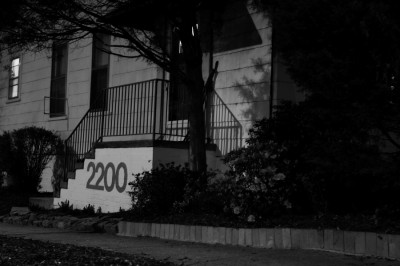
According to the 1914 Sanborn Insurance Map the street was originally called “Post Office Street”, on account of the West Raleigh Post Office which was near the spot where Hope Street now intersects it. By 1950, the name was officially known as Enterprise Street, but still referred to as Post Office Street in parentheses. The 1914 map indicates the street was a dead end, but by 1950 it served as a connector to Clark Avenue, and most importantly, Cameron Village.
The 1950 map makes no reference to Garden Place, but the street and a few of the houses on it date back to at least the 1940s. A landowner who rents out a duplex at the end of it lived there when he was in college, and he is now in his late 80s. There is a rather large garden on Garden Place — sometimes it is tended to and sometimes not. Garden Place dead ends in to an area colloquially known as “The Sac”, as in cul de sac.
Despite being only a few dozen feet from Hillsborough Street, there are a few hidden places directly off of it, such as the tree house of Hope Street and the unorthodox living quarters or storage unit in the photo above.
One of the most recognizable is the rooming house/apartment building at 10 Enterprise. The neon light advertising the address is quite the uniquity, leaving no question as to the location.
Jasmin, a resident, was kind enough to show me around the house that dates back to the very early part of the 20th century. The owner of the house is also the former owner of the Fallout Shelter, a club that thrived downtown in the spot now known as Flex. He has several artifacts from the club in the attic, including the neon beer signs in the photo above.
Hidden from view is a balcony on the North side of the house, which provides a view of Enterprise Street not seen by many.
Until about two years ago, the one and a half story green house across from the Hope Street intersection sat vacant.
One day while walking along the street, I noticed boxes of mementos and other odd items sitting on the curb in front of the green house. It was being renovated and emptied of the belongings of the former resident, and piles of memories sat on the curb awaiting a trip the landfill.
Naturally I was curious as to why someone would discard so many photos. Unashamedly I started pilfering through the refuse, satisfying a weird and almost morbid sense of curiosity of the person who once lived there. It was mostly yellowing photos and postcards, showing people whom I would never meet and never know.
In addition to the images seen here (and others lost within my unorganized piles of old 35mm photos in shoeboxes), there was a WWII-era gas mask, a soldier’s utility belt, a field medical kit, among other millitary items. It struck me as incredibly odd that someone would leave such items in a box on the curb. Perhaps they couldn’t find the heart to dump them in trash bags.
At the other end of the street lies the North Carolina Nurses Association building. A set of stairs to nowhere on the Clark Avenue side lends a clue to the property’s past: likely a large house that fell in to disrepair and was demolished.
On the other side of the NCNA building lies a rather elegant stairway leading to the second floor. I’ve heard it’s rarely used throughout most of the year, as the large glass panels contribute to a greenhouse effect, making the space incredibly hot and humid.
—
Enterprise Street and the areas around it serve as a home to college students, professionals, familes, businesses, administrative divisions of NCSU, as well as providing a thoroughfare for those on their way to Cameron Village or to Hillsborough Street. Despite being a fraction of a mile long, it has more diversity, character, and charm to it than most streets several times its length. It’s one of the most often overlooked and underappreciated livable neighborhoods in Raleigh.

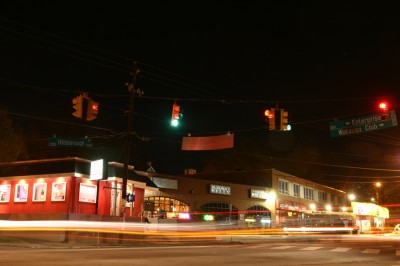
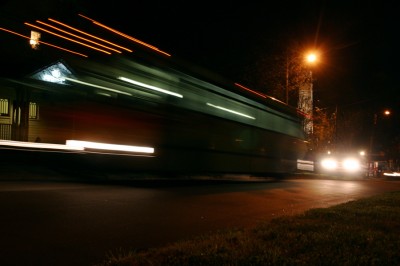
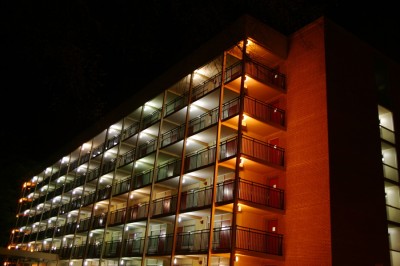

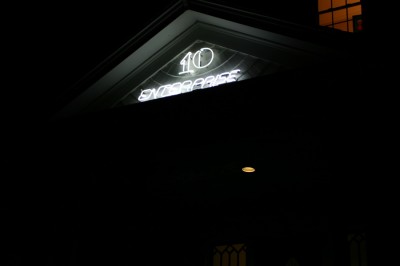
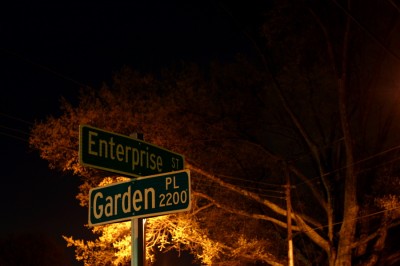

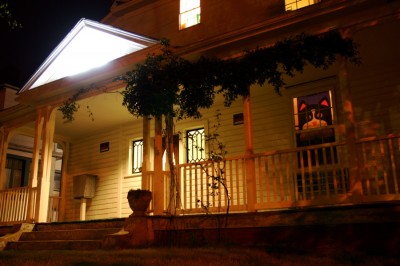
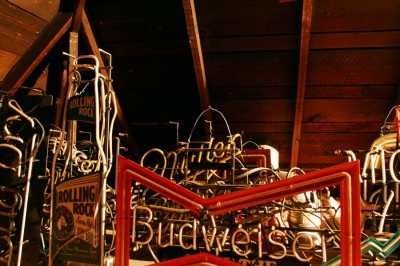
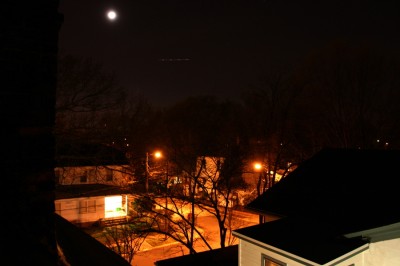
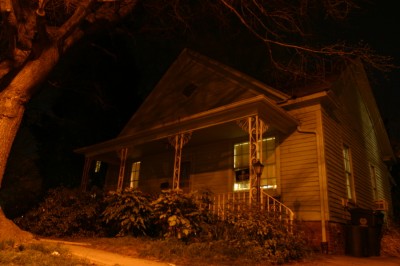
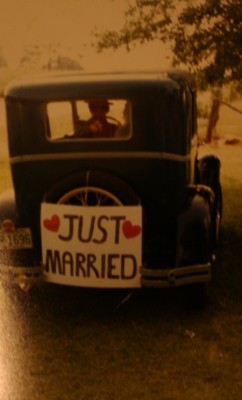
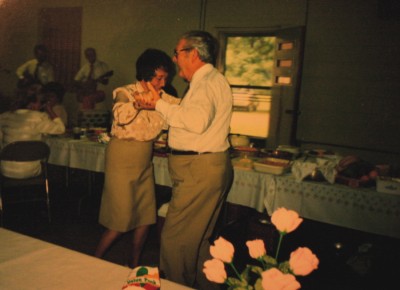
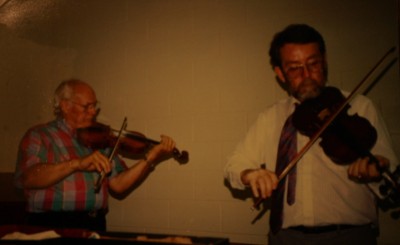
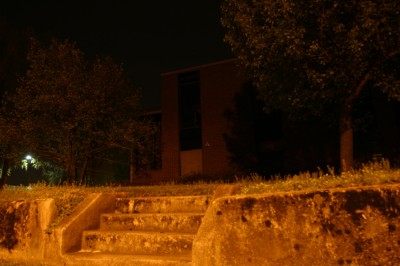
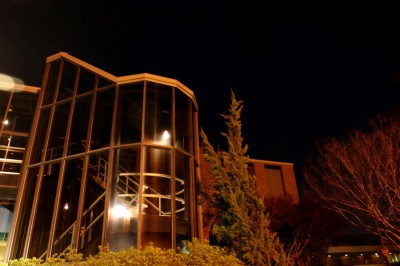
 Sign up for the Newsletter
Sign up for the Newsletter
03/31/2009
next time go behind Buddha’s belly and get some shots of the artwork that bart and brandon threw up. (if it’s still even there??)
03/31/2009
I don’t know about the seventh day adventist part, but that white house above is at least an LDS establishment called the Raleigh Institute of Religion ( http://www.lds.org/institutes/home/0,8473,768-1-36-60139,00.html )
03/31/2009
I love this post! Told as only a denizen of the neighborhood could. The LDS house (no. 6) was the last one on the street to be occupied by members of the same family who built it. Mr. Roland, who was born there in the early 1900s, was its last occupant before it was sold out of the family back in the 1980s. I remember very well sitting at a bar stool at Sadlack’s many a Sunday afternoon, and in would come Mr. Roland, with a yellow sticky note pad handing out the temperature written down on a piece of the paper. If you sat there long enough, you’d see Mr. Roland make regular hourly trips down to Sad’s all afternoon to hand out the temperature. He was quite a character.
03/31/2009
6 Enterprise Street was the Chi Omega sorority house in the late 1980’s and 1990’s. I spent quite a bit of time there during my years at NCSU. It’s beautiful inside as well.
03/31/2009
karla anne – I believe it’s still there, if so I’ll get a picture and add to this post.
rgl – I have corrected it in the post, thank you for the clarification.
Suzie – I had heard that, but did not know it was that recent. 10 Enterprise had served as a frat house for some time too. In fact, it is labeled as such in the 1950 Sanborn map.
RB – handing out the temperature? I’m perplexed! Was there a purpose? What were people’s reactions?
03/31/2009
haha– well, it’s hard to explain. Mr Roland was getting on in years, and this became a routine for him. He apparently had a thermometer up at the house, and delighted in letting the Sadlack’s folks know the change in temperature over the course of the day. He’d write the temp on the yellow sticky notes and hand them out to the customers. He’d repeat this over the course of the day. We came to look forward to his reports, as it seemed he really enjoyed sharing that info with us. Seems I recall he always wore a white shirt and tie. Ask any of the long-time habitues at Sad’s –They’ll tell ya!
03/31/2009
I think Chi Omega bought the house (6) in 1987 or 1988 and did some renovations. I pledged in 1989. I think it was the first year the sorority was in the house. Sometime in the 2000’s, Chi Omega moved out to a bigger and less interesting house.
04/01/2009
Uh boy.
“I’ve been following you since you left Enterprise Street . . . ”
I heard those words once way back when I was 17 years old and one of Raleigh’s finest stopped me on Morgan Street in front of the old bus station. I had been getting my first taste of underage alcohol on Hillsborough Street, back when Ed’s Gro, Crazy Zacks, Darryl’s, et. al. occupied the block where Red Hot and Blue is now. I had parked on the street near Sadlack’s and was heading home. Thank goodness that policeman stopped me. I was young and dumb and Raleigh and the times were quite different, so I didn’t get into any real trouble. But I learned my lesson. I ALWAYS think about that night when I drive past Enterprise Street.
And though I’ve lived in Raleigh nearly all my life, I’ve never been to Sadlacks or the PR. I know. Shame shame!
Thanks for another fine, memory-evoking entry, John.
04/03/2009
#10 was at two points in its life a fraternity house – Phi Pi Psi in the 1930s, and Alpha Sigma Phi from 1977 to 1986. I am an Alpha Sig from the latter time, lived in the room first floor on the left side. We used to sort of take care of the Rolands…when Mrs Roland broke her hip we were there to help out. The house was frozen in time, the 1920s. Amazing. Even freakier was that Phi Pi Psi merged with Alpha Sigma Phi on a national level in 1939, and somehow the rechartered Alpha Sigs ended up in the same house years later, totally by coincidence.
Mr Roland would tell stories of being at NCSU in the teens…what class gave what monument to the school etc. He was getting a bit daft by then; he’d totter out of his house, up Enterprise and over to the Raleigh Federal Savings & Loan at Oberlin and Clark. He’d get the temperature from there. And he had a route he’d walk/totter thru the Village as well, doing the temperature thing…
04/03/2009
Zman — Thanks for sharing your memories of the Alpha Sig house and the Rolands. Mr Roland was a character indeed! Didn’t know he made it all the way up to Cam Vill to get the temperature. I also remember him telling the stories about NC State — now wish I’d written that stuff down!
04/03/2009
Oh the sac. Oh Enterprise. I right miss walking down that street everyday. It has so many memories for me, both good and bad.
It was good it got cleaned up in recent years, but I always liked how bum-friendly that shopping center was.
Sadlack’s for food and spirits, a headshop, a late night barber shop, a pawn shop, a tiny restaraunt with a pool table, an a loiter-friendly c-store. In case you needed money, you could sell plasma upstairs, just beyond the payphone/urinal.
If you’ve never eaten at Sadlack’s, I encourage it. It isn’t as seedy as it seems, and their lunches are great.
04/06/2009
While at State I lived one street over on Maiden Ln, but our fraternity house backed up to Enterprise. I believe Chi Omega moved out in 2000-2001 to a new house over on Avent Ferry.
The collection of characters living on Enterprise and Maiden still makes me laugh to this day. There’s never been a more motley crew than those that hang out on the stretch of Hillsborough St. in front of Sadlack’s, Buddha’s Belly, the black barber shop, and the the BT Mart. It’s one of those places that’s held together by some convergence of serendipity, poverty, and little charity here and there.
My favorite two instances involve:
1) The time that our big-screen TV was stolen, and then the following day, was brought back, no doubt due to some helpful neighborhood reconnaissance.
2) The time that wheels were stolen off of my car and located on a neighbor’s car 2 houses down. This led to a hilarious exchange where an offer was made to trade my wheels in exchange for some moonshine (made in the top tank of a toilet).
I’ve talked to several people who’ve lived near those blocks while attending State, and everyone seems to share the opinion that it helped define their college experience.
If anyone has any info on what North Hall was like before the University owned it, I’d like to hear it (what hotel, circumstances around it’s closure/sale, etc.)
04/06/2009
raleighcollins – Here’s some info on North Hall from the NC State web site. Before the hotel was built around 1972, that whole block was houses. There was a large frame apartment house on the corner of Enterprise St. There was also one house whose owner refused to sell to Lemon Tree, so they just built around it — a ‘Nail House.’ I guess the hotel finally made an offer he couldn’t refuse, as it was torn down a year or two later.
“North Residence Hall, located on Hillsborough Street, was originally the Lemon Tree Inn, a privately-owned hotel. Later it became the John Yancey Hotel, offering a restaurant and “Merry Monk” nightclub to visitors. The hotel was a favorite establishment among legislators and other politicians during the 70’s. When enrollment increased at NC State in the 1980’s, the University bought the hotel to serve as a residence hall.
“Yancey donated all of the furniture and North Hall became the first dormitory on campus to have air-conditioning and other amenities. A strict conduct policy was designed to make sure that the new residents, who called the building “merry monk dorm,” kept it in good condition. The adoption of North Hall became the first time that NC State had independently purchased off-campus property for student housing.”
04/15/2009
I lived at 10 Enterprise Street for several years in the early 90’s. I had some of the best times of my life back then. I used to walk to one of my part-time jobs at Balentines Cafeteria at Cameron Village. Sadlack’s was always buzzing while I washed my clothes at the laundromat that eventually became the pawn shop I believe. I used to love listening to the hourly chimes coming from the Bell Tower. Dusk most always ushered in beautifully brush-stroked colors of light and shadows through the windows of my little efficiency. Several people who lived at 10 Enterprise at the time I did have told me they have seen the ghosts of an old man in overalls standing with a young girl at the top of one of the stair landings. I was also told by one of these individuals that they had seen the same young girl staring out what was my upstairs bathroom window facing Enterprise…she was crying. The house next door was a girl’s sorority at the time. They often had activities which were fun to watch from the window, such as boys in tuxedos serenading, groups of girls standing outside together reciting one thing or another out loud, and whatever else sorority girls do. As far as the house on Enterprise that was mentioned in an earlier post with the memorabilia by the curb, I think that was Mrs. Weatherman’s home. She was still living there when I was around. Her grandson is Woody Weatherman who is in the awesome band Corrosion of Conformity from Raleigh. I sure do miss that street and the surrounding neighborhood.
09/09/2009
Kim is correct. The green house was the Weatherman’s house (of Weatherman’s Jewelers….Where Loco Pops resides now). She is the lady dancing in the photo. I believe her son Tony Weatherman (Woody’s Dad) is the man playing the fiddle in the other photo (he ran the shop and did clock and jewelry repair for many years). Mrs. Weatherman lived in the green house for many years (she died not too long ago). I can’t believe her relatives left so many things behind. Woody (from COC) went to Broughton. I lived on Maiden Lane from 1987-1990 and there was always some action across the street at the Plasma Center. Back then there was crazy John at the record store Changes (now Buddha’s Belly) and Gator’s and Alligator Alley were serving up the greasy breakfasts. Rechenbach’s was beside Steve’s Ice Cream and weed was sold in the back parking lot. Stroh’s Dark (with a lemon) was on tap at Saddie’s and the Big Mike was waiting on the plate.
09/09/2009
Oh there used to be a swimming pool directly across Enterprise from Sadlack’s parking lot. It belonged to the original hotel (the Lemon Tree Inn). The university boarded it up and later demolished it (for fear that students would party too much, get hurt, etc.).
09/09/2009
Tony Weatherman is the man in the foreground of the photo (with the white shirt and tie on).
09/11/2009
That is Toney Weatherman in the foreground and the gentleman in the back is Lonnie Austin from the N.C. Ramblers. Mr. Roland was Register of deeds for Wake county for many years. He was born in the house and lived there until him and Ruby moved to Springmoor when they sold the house. The green house is the oldest house between St. Mary’s street and the fair grounds.
09/11/2009
yes, Karen you are right. I remember him telling me about his career as RoDs.I think he spelled his name Rowland, though. At least that’s how it’s spelled in the deed books.
The Green House– yes, I think you are right. I’m guessing 1901-02 was when it was built. All the older homes once on Hillsboro St are long gone. And the ones still standing date from 1910 or so– like the Williams house at the corner of Park Ave., which I think is 1909.
09/12/2009
Mr. Rowland told us that 14 enterprise was from the 1800’s and an old farm house and the only house around. The brick apartment house next to it was a two story house in the 40’s till the 80’s and it was the post office before that. Dr. Nelson the dean of textiles live in it in the 50’s.
09/12/2009
14 enterprise was the birth place of one of the governors of new jersey we do not know which one Mr. Rowland told us this also. 12 ENTERPRISE has always been an apartment building.
09/12/2009
MR. ROWLAND would walk up Emterprise to Raleigh savings and pick up matches and go by sam and bills and give them matches with the temperature on the books and then come by Weathermans and leave us matches with temp and pick up a couple of pieces of candy and go on up the street giving out candy stopping sad lacks and then back home what a wonderful man and Mrs. Rowland (Ruby) would come to 14 enterprise every christmas morning with fresh baked cookies she cut out and painted what wonderful peopled.
10/29/2009
does anyone remember the annual maiden lane party? it usually had a bunch of hardcore bands.. aftermath a.d. them, spawn, bloody mary. it was a fantastic party, it usually had the whole hardcore scene from fallout shelter and the like… god i loved those days. 1991-1994 was when it was happening
06/26/2011
For a brief while in the late 80’s I lived 21 Enterprise – it was a big white house that had been turned into upstairs and downstairs apts. (It burned down and was replaced by the duplex that’s there now). The downstairs came with a semi-finished basement which included a weird dorm-style shower… always wondered what the history of that building was and why someone built that crazy bathroom in a half-finished basement.
10/20/2012
My family lived on Enterprise St. In the early 1960’s and soon bought 2210 Hope St. My mother owned the restaurant and bar at Western Lanes and walked home in the wee hours of the morning. I remember college students knocking at our door and asking if we could rent them a room. She mulled it over and we soon had students from the basement to the attic. She lamented the decline of the neighborhood, but that didn’t stop her from paving her tiny lawn, in the early 70’s, to provide a couple of parking places. I don’t remember when she sold her house and moved to N. Raleigh. I loved walking back and forth to Broughton and spent lots of time on Hillsborough St, seeing every movie that came to The Varsity(?) and spending my allowance at the used bookstore between Baxley’s and Western Lanes. I wish I could remember the name of the bookshop and the lovely people who owned it. There was also a dime store along there in the mid-50’s.
08/11/2016
Most of the East side of Enterprise Street and almost all of Maiden Lane to be demolished to make room for a $100 million three story retail on first, apartments on the second and third floors. Everything fronting Enterprise from the Mormon Church to the bank to go. Good bye Raleigh!
08/19/2016
Never knew who Mr. Roland was by name but clearly remember the guy w/ the time & temp from when I was at State 80-84.
Steve Guth, where is there news of this newest development? Bound to be more of the soul-less crap sprouting on H St. and all over downtown. Had lunch at Wild Cook’s today and the 2 other folks in the car and I panned all that we saw new on the street.
12/01/2016
I lived at 10 Enterprise from the fall of 1971 until the spring of 1975. I lived upstairs with 4 others. The apartment was inherited by one of the guys from his sister who had lived there when probably less than 10% of the students at State were women. I believe the rent was $160 for the whole upstairs. Several of us still get together for reunions. Most of us were on the fencing team then when State had a team but it was dropped a few years later. There were 3 smaller apartments downstairs. The backyard was for parking. The apartment was hot in the summer and cold and drafty in the winter especially when the Energy Crisis of 1973 hit and fuel oil prices went up. I remember how quite it was on Enterprise Street when gas could not be bought on Sundays! I don’t remember ever locking the doors or closing the doors to the inside stairs except at Christmas when everybody left.
We knew the Rowlands next door. They were surprisingly nice and friendly to us students; perhaps they were used to having students next door and few permanent, “real” neighbors. I think Mr. Rowland was still the Regester of Deeds then but may have just retired. She gave us a tour of the house one time. I believe she said Mr. Rowland had lived there all his life. The light fixtures still had two sources of light, one for electricity and the other for gas. Early on electricity was not reliable! There may have been a room for a butler too.
When I first lived at #10 there were still houses along Hillsboro Street. A “tourist home”, like a bed and breakfast, was on the corner. Another house served meals to students and may have been a boarding house too. I remember construction of the hotel during one spring and summer. One of the precast walls fell flat one morning and woke us up. The chimes from the bell tower were our usual alarm clock. Since classes started at 10 minutes after, we had time to get ready and get to campus. It was a very convenient location right across from campus when almost all campus was located there. The house behind the tourist home was occupied by a professor from the School of Design. At the end of the semester before the hotel construction began they had a big party and practically demolished the house. So much for reverence for the houses on Enterprise!
Were you aware that there was a basement under 10 E? But the house was not built with a basement. The fraternity members decided they needed a party room and started digging. It was eventually completed into a decent space but I don’t know when.I only remember going into the basement once. I don’t know if anyone ever lived there.
Long-time NC Commissioner of Agriculture Jim Graham lived at 10 Enterprise before WWII. In the late 70’s I heard an interview on WPTF radio asking where people had been on December 7, 1941, Pearl Harbor Day. Jim Graham was interviewed and said he was at the fraternity house at 10 Enterprise Street! I had a chance to talk to him about 25 years later and asked him about it. He had lived there and helped dig the basement. He also mentioned the Rowlands.
Kim in a post above mentioned ghosts being seen at the top of the stairs. One night (or maybe several times)I saw figures (maybe a man and little girl) through the window in the living room across from the stairs toward #12 while sitting on the couch with my back to the stairs. It was startling! Having watched many Sherlock Holms movies on late night TV at 10 E I was determined to find out what it was. It turns out a roommate had gotten a billboard poster and put it up on the wall above the stairs. What I was seeing was a reflection of the picture on the window but it appeared to be outside the window hovering two stories off the driveway.
02/28/2018
All of these houses have been demolished in the last week. I took a video while the bulldozer was chomping up one of the boarding hoses. End of an era. I can’t find anything about what’s going in there.